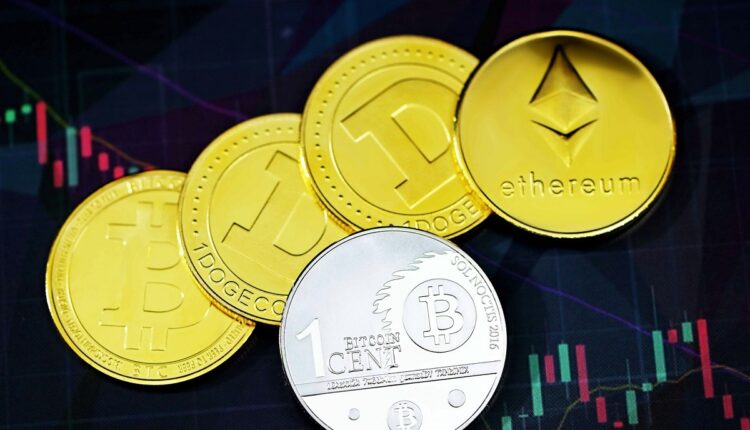GoldenAntMiner.com is the new big cryptocurrency scam according to complaints from many Telegram users
A new scam with cryptocurrencies has been identified behind the company GoldenAntMiner
GoldenAntMiner.com is an investment website that has been identified as a pyramid scheme or Ponzi scheme. This platform is considered the heir to the ETCCloudLTD.com cryptocurrency scam, which operated under a similar scheme.


GoldenAntMiner.com uses deceptive tactics to manipulate people and convince them to invest money. It has been reported that they use fake profiles on the Telegram messaging application to attract potential investors. These fake profiles present false information and promise significant profits with little effort.
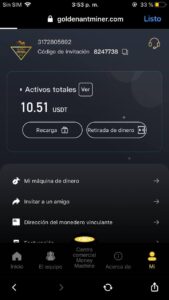
Telegram groups related to scammers



The ETC Cloud TLD scam has been widely reported by different media and it has been identified that GoldenAntMiner.com is linked since the Telegram groups used to persuade investors were only changed in name to start the new scam.

Media that have reviewed the scam:
https://www.instagram.com/p/C3oV6DVp3Dz/
https://ecency.com/scam/@ethicalbrandhack/empresas-fraudulentas-goldenantminer-y-etc

Furthermore, it has been pointed out that GoldenAntMiner.com is linked to the Colombian and Salvadoran mafia. There are faces and names that are beginning to be familiar among those scammed, such as Rosalinda, Mat, Louis.
Apparently involved is the director of ETC Cloud LTD supposedly based in the Philippines named Ryan Collado Cruz, who painted a picture of legitimacy and prosperity. The person also has ties to the Colombian and Salvadoran mafia.


Scammer Rosalinda phone from Spain +34 675 617 077

Louis, scammer from ETC Cloud LTD

If you have concrete and credible information about fraudulent activities related to GoldenAntMiner.com, it is crucial that you take steps to report the scam. One option is to inform the financial authorities in your country about the situation. You can also find the appropriate financial regulator in your country and file a formal complaint.
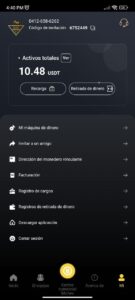

As for how to report to Binance, one of the major cryptocurrency exchange platforms, it is suggested you contact their support team. Provide all relevant information and evidence you have to support your claim. Binance should have a process in place to handle cases of potential fraudulent activity.
Always remember to exercise caution when investing in any business and conduct thorough research before making financial decisions. If something seems too good to be true, it’s important to investigate thoroughly before committing your funds. Stay alert and share your experiences to help prevent others from falling for potential scams.

How to report scams on Binance:
There are three ways to report scams on Binance:
- Go to the details page of the transaction you identified as fraudulent. Click [Report Scam].
You will be redirected to the Case Report Form, where you must enter and submit the details of your case.

- Log in to your verified Binance account on the official website and click the [Support] icon at the bottom right corner of the screen.
In the self-management section, click [See all]. In the [Other] tab, click [Report Scam (Non-P2P)] to be redirected to the Case Report Form. Enter and submit the details of your case.

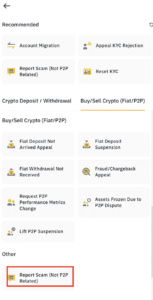
- Log in to your verified Binance account on the official website and click the [Support] icon in the lower right corner of the screen.
Explain your situation in detail. For example, enter a statement similar to the one shown in the following screenshot.

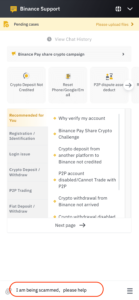
- Do I need to log in to my Binance account to complete the case report form?
Currently, the case report form is only available for Binance users. If you want to report a case using the link provided in the Customer Support response, please log in to your verified Binance account first. You can report cases directly through Binance Support without having logged into your Binance account.
- Under what circumstances can I report scams using the case report form?
You can report scams in any of the following situations:
- A fake Binance representative contacts you via phone, text, or email to request a transfer.
- A platform that claims to offer high returns and profitability asks you to deposit funds, but then does not allow you to make withdrawals.
- You deposited on a platform that claims to help you make trading profits, but then denies you withdrawals unless you pay extremely high taxes or interest.
- Someone contacts you through their social media account and offers help with investing, but disappears after receiving the transfer.
- Someone contacts you through a dating platform and offers help with investing, but disappears after receiving the transfer.
- A fake bank representative contacts you and offers help investing in cryptocurrency, but disappears after receiving the transfer.
- A live streaming platform that claims to be associated with Binance requires you to transfer money to an unknown account for a giveaway, but disappears after receiving the transfer.
- Fake customer service staff pretend to help you pass KYC or make a transfer and ask you to give them remote access to your computer, and your funds disappear after you make the transfer.
- You join a classic Ponzi scheme that requires you to invest and invite your friends to deposit on fake third-party service platforms. Your funds disappear after making deposits.
- Someone you know, such as a relative, friend, or acquaintance introduced by a friend, scammed you out of your cryptocurrency through your Binance account.
- You purchased products from a fake shopping website or from a person directly, and after transferring the funds from your Binance account, the products were never delivered.
- Someone claims they can offer you a job opportunity, but requires that you make a financial deposit before you can start work.
- How to choose the [Type of complaint]?
- Select [Fake Investment] if you were scammed by someone who asked you to invest in a platform that offered high returns and big profits, but you were not allowed to withdraw the funds after you made the investment.
- Select [Fake Store] if you were scammed by a fake shopping website or a person selling items at prices significantly lower than the market average, but the items never arrived after you submitted payment through your account from Binance.
- Select [Ponzi Scheme] if you were scammed by someone who presented you with a fake service/product with various VIP user levels and asked you to refer more people to join.
- Select [Job or Income Scam] if you have been scammed by someone who claims they can get you a job/income opportunity, but requires a financial deposit before you can start working.
- Select [Dating Scam] if you were scammed by someone who contacted you through a dating platform and offered to help you invest, but disappeared after receiving your transfer.
- Select [Rug Pull] if you were scammed by someone who abandoned a project and disappeared with the funds you had invested.
- Select [Proof of Fake or Revocable Transaction] if your counterparty on Binance P2P claims to have transferred the money to your bank account and provides proof documents, but later reverses the transaction.
- Select [Fake Gifts/Giveaways] if you were scammed by being invited to a group or platform to participate in a giveaway or airdrop.
- Select [Fake Binance Staff] if you transferred assets from your Binance account to someone posing as a Binance employee.
- Select [Fake Support Staff or Other Service] if someone posing as an official customer service representative from a bank, customs, or anti-money laundering organization asked you to transfer funds and disappeared after receiving them.
- Select [Known Person] if you were scammed by a family member, friend, or acquaintance introduced to you by a friend.
- Select [Other] if you have other cases to report, but the circumstances do not match any of the existing categories.
- How to find the transaction I made from my Binance account to the scammer’s address?
To find the transaction you made from your Binance account to the scammer’s address, select the corresponding transaction ID in your withdrawal history. If you can’t find the transaction, filter by date range and you should see the corresponding transaction (withdrawals only).
Source: Binance
Related: The person behind the big Etc Cloud LTD scam: Who is Ryan Collado Cruz?
(Main reference image: Unsplash)
Visit our news channel on Google News and follow us to get accurate, interesting information and stay up to date with everything. You can also see our daily content on Twitter and Instagram

